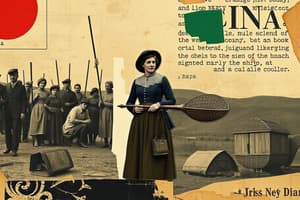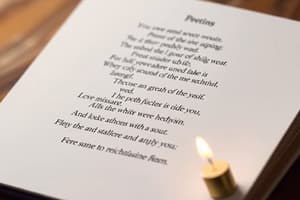Podcast
Questions and Answers
What is a recurring theme in Eavan Boland's poetry?
What is a recurring theme in Eavan Boland's poetry?
- The Power of Nature
- Urban Landscapes
- Womanhood, History, and Loss (correct)
- Romantic Love
Which of Boland's books explores the theme of motherhood and domestic spaces?
Which of Boland's books explores the theme of motherhood and domestic spaces?
- The Famine Road
- Child of Our Time
- This Moment (correct)
- The Black Lace Fan My Mother Gave Me
How does Boland challenge traditional narratives in her poetry?
How does Boland challenge traditional narratives in her poetry?
- By ignoring the historical context of women's struggles
- By using only literal language and avoiding symbolism
- By focusing exclusively on the political experiences of women
- By highlighting the personal and political experiences of women (correct)
What is the significance of Boland's use of symbolism and imagery?
What is the significance of Boland's use of symbolism and imagery?
How does Boland's use of symbolism and imagery affect the reader's understanding of her poems?
How does Boland's use of symbolism and imagery affect the reader's understanding of her poems?
Flashcards
Eavan Boland's themes
Eavan Boland's themes
Important themes in Boland's poetry include womanhood, history, and loss.
Symbolism in This Moment
Symbolism in This Moment
Explores motherhood and domestic spaces through imagery.
Loss in Child of Our Time
Loss in Child of Our Time
Addresses the themes of loss and innocence.
Memory in The Black Lace Fan My Mother Gave Me
Memory in The Black Lace Fan My Mother Gave Me
Signup and view all the flashcards
Oppression in The Famine Road
Oppression in The Famine Road
Signup and view all the flashcards
Study Notes
Eavan Boland's Symbolic Poetry
- Boland's poetry uses symbolism and imagery to explore themes of womanhood, history, and loss.
- Her work challenges traditional narratives, highlighting personal and political experiences of women.
Motherhood and Domestic Spaces
- This Moment uses simple yet profound imagery to symbolise maternal love and protection.
- The poem portrays a dreamlike atmosphere using the setting sun, darkening streets, and a child's open mouth.
- It elevates ordinary moments of a child running to their mother and makes them deeply significant, celebrating the universal female experience.
Loss and Innocence
- Child of Our Time contrasts childhood innocence with the brutality of violence.
- This poem is in response to the 1974 Dublin bombings.
- The loss of a child is tragically represented.
- The imagery of lullabies highlights the failure of adults to adequately protect children.
- The title itself symbolises the child becoming a tragic representation and how profoundly war and violence affect women and children.
Memory and Female Identity
- The Black Lace Fan My Mother Gave Me uses a black lace fan to symbolise love, loss, and the passage of time.
- The poem reflects on how women's histories are often connected to objects that hold memories.
- Weather imagery (heat, storm, humidity) represents passion, conflict, and inevitable change, and mirrors personal and historical transformations.
Oppression and the Forgotten Female Voice
- The Famine Road connects national history with the oppression of women.
- It creates parallels between the famine roads and female suffering.
- The poem links women's experiences with Irish workers suffering during famine.
Conclusion
- Boland's use of symbolism and imagery transforms traditional narratives and sheds light on the hidden struggles of women.
- Through everyday objects, nature, and historical references, she reclaims the female experience.
- Her work ensures women's voices are no longer silent in Irish poetry.
- The brutal imagery of starvation, suffering, and decay in the poem represents the marginalization of both poor Irish people and women.
- The dismissal of the barren woman as a "famine road" highlights the dehumanizing reduction of her value to a mere physical space.
Studying That Suits You
Use AI to generate personalized quizzes and flashcards to suit your learning preferences.




